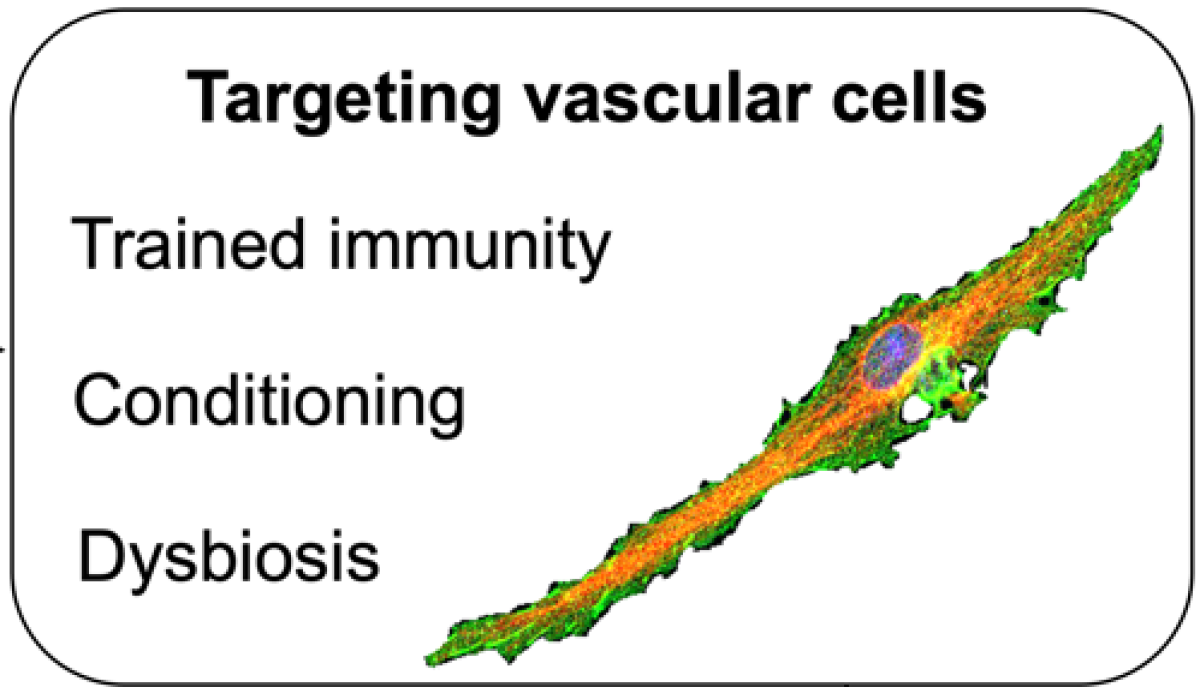Research Area 2: targeting vascular cells
Injury following reperfused myocardial infarction is not restricted to cardiomyocytes, but affects also the coronary microvasculature, ranging from endothelial dysfunction, platelet-leukocyte aggregation to capillary rupture. Coronary microvascular injury is an independent predictor of poor prognosis, above infarct size per se, and is also a target of cardioprotection. Targeting the cardiac vasculature remains one of the central goals of cardioprotection in reperfused myocardial infarction because it is a trigger of the inflammatory response but is also negatively affected. Once activated, endothelial cells take part largely in the regulation of responses. Cytokines, which are released in the infarct area, mediate the expression of endothelial adhesion molecules (e.g., vascular endothelial adhesion molecule 1 or intercellular adhesion molecule 1 [ICAM-1]) to promote the interaction with circulating leukocytes. Endothelial cells themselves release proinflammatory chemokines, but the functional integrity of the endothelial layer is under the control of a magnitude of influences. Increasing evidence has shown that the gut microbiome is crucially involved in the pathomechanisms of cardiovascular disease by modulating immune homeostasis through bioactive metabolisms in distant organs. Most of the microbiota resides on the surface of the intestine and is indispensable for physiologic homeostasis. Alteration of microbial communities, termed dysbiosis, has been linked to chronic inflammation and obesity and has been shown to determine the myocardial infarct size in a preclinical model. Loss of gut microbiota was described to increase mortality rates and to reduce regenerative capabilities in reperfused myocardial infarction through microbiota-derived metabolite modifications. Probiotic administration preserved the deterioration of ventricular function in a preclinical model of chronic myocardial ischemia. Pathophysiologic mechanisms are highly affected by metabolites processed by the gut microbiota, including short-chain fatty acids and trimethylamine-N-oxide (TMAO). High levels of TMAO promote inflammatory responses, and their administration activates the nucleotide-binding oligomerization domain-like receptor protein 3 (NLRP3) inflammasome and promotes monocyte adherence. Recent clinical evidence supports the notion of an ischemia- and/or stress-induced dysbiosis, particularly in the setting of reperfused myocardial infarction. Mechanisms include left ventricular dysfunction with consecutive intestinal hypoperfusion that causes intestinal mucosa injury and gut barrier failure with succeeding microbial and metabolite translocation into systemic circulation, initiating the inflammatory response. Regulatory T cells (Tregs) have been identified as a key modulator of inflammation, and the intestinal microbiota modulates Treg generation and functional specialization. Metabolites have been reported to promote Treg homeostasis. Microbiota-induced interleukin-17 (IL-17)-producing-γδ T cells are an important innate immune cell population in the intestinal epithelium. These cells are involved in the maintenance of gut homeostasis and regulation of inflammation. Interactions between the microbiota and γδ T cells affect both tissue homeostasis and disease pathologies; distinct populations affect late-stage LV remodeling in reperfused myocardial infarction. Intestinal dysbiosis alters immune homeostasis and leads to an increase in Treg counts and an alteration in IL-17+ γδ T cell numbers. Derived IL-17 contributes to myocardial ischemia/reperfusion injury by regulating cardiomyocyte apoptosis and neutrophil infiltration and is a key component in vascular dysfunction. Whether myocardial infarction induced dysbiosis affects endothelial cell function by a modification of the microbiome or by interaction with T cells needs further investigation.
Increasing evidence implicates a relevant role for microvesicles in intercellular crosstalk. Vascular endothelial cell-derived vesicles are members of the family of extracellular vesicles, shed from activated or apoptotic cells. The results of a recent study using a human heart-on-chip assay suggested that human vascular endothelial extracellular vesicles may protect cardiac tissue in reperfused myocardial infarction. Upon treatment, cardiac cell death and the loss of contractile capability were diminished, and respiratory capacity was improved. Remote ischemic conditioning by brief episodes of ischemia/reperfusion in limbs before reperfused myocardial infarction is a non-invasive strategy for protecting the myocardium of patients undergoing interventional acute surgical coronary revascularization. Signals potentially released from peripheral vessels to the heart are probably transported via the circulation, because cardioprotection can be transferred from one species to another via plasma. Remote ischemic conditioning increases the circulating levels of microvesicles, thus contributing to protection of cardiomyocytes. Understanding the source and amount of the microvesicle release, the distinct composition of these microvesicles, and the interaction with coronary vasculature and the mechanism of cardioprotection in reperfused myocardial infarction requires further investigations. Recently, it has been speculated that cardiac cells can cause trained immunity induced by myocardial infarction events. The phenomenon of trained immunity is postulated to be exerted through non-immune cells, such as coronary vascular smooth muscle cells. Whether epigenetic modifications enable cardiomyocytes to train immunity is unknown. Cardiomyocytes are suggested to undergo training induced by myocardial infarction events. A concept of “trained immunity” has been proposed previously, in which previous pathogenic challenge primes cells for a stronger inflammatory defense response to subsequent triggers. Immune training involves epigenetic reprogramming, with transcriptional and metabolic adaptation from oxidative phosphorylation to aerobic glycolysis. This adaptive reprogramming is an essential basis for host fitness and non-specific protection by vaccines against infections. However, inappropriate activation contributes to auto-inflammatory diseases and post-sepsis immune paralysis. Recent evidence suggests that simulated hypoxia/reoxygenation evokes epigenetic modifications in cardiomyocytes and fibroblasts, but no “cardiomyocyte memory” has demonstrated so far. The specific aims of this Research area are (i) characterization of the role of the microbiome in the progression of vascular injury in reperfused myocardial infarction, (ii) identification of the vasculature as a potential target of remote ischemic conditioning and the consequences for cardioprotection, and (iii) assessment of "trained immunity mechanisms" from reperfused myocardial infarction. Consequently, experimental approaches and clinical studies (co-supervised by a clinician and a basic science researcher) will be used.


